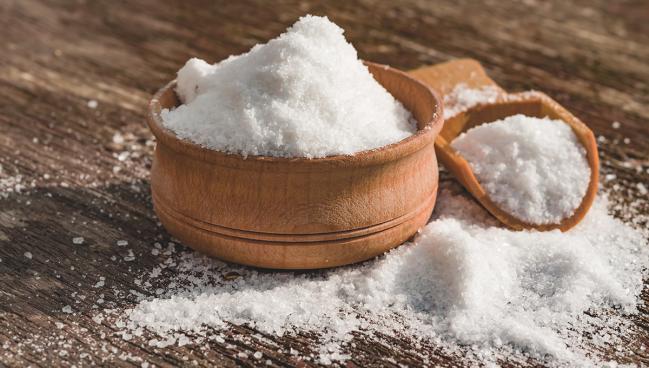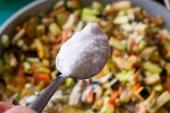Salt Substitute Slashes New Hypertension Diagnoses: DECIDE-Salt
A “passive” strategy of replacing salt in food without patients doing anything may have profound effects, says Eugene Yang.

In older adults with normal blood pressure values, incorporating a salt substitute in place of regular salt may decrease the risk of new hypertension by as much as 40%, according to a post hoc analysis of the DECIDE-Salt study.
Participants in the study, who were over age 55 and living in residential care facilities in China, were randomized to have food preparers use either a customized salt substitute or usual salt. Over 2 years, the incidence of hypertension was 11.7 per 100 person-years in those who ate the food made with the salt substitute versus 24.3 per 100 person-years in those who ate meals prepared with regular salt.
Importantly, there was no increase in hypotension among those consuming the salt substitute, which can be a concern in older adults with multiple comorbidities and polypharmacy, note the investigators, led by Xianghui Zhang, MSc (Peking University Clinical Research Institute, Beijing, China).
They believe the study demonstrates that the salt substitute is “much safer than antihypertensive medications, which have been proven to be associated with an increased risk of hypotension.”
Beyond this study setting, Zhang and colleagues say the concept “shows itself as a desirable population-wide strategy for the prevention and control of hypertension and cardiovascular disease.”
Support for the potential for CVD reduction is based on DECIDE-Salt’s unique primary endpoint of incident hypertension, which was defined as BP ≥ 140/90 mm Hg at two or more follow-up visits, initiation of antihypertension medications, or development of MACE during follow-up.
“If we could replicate this in schools and by [encouraging] people who are making packaged foods to reduce the sodium through use of a substitute, then at the societal level the implications could have profound effects on blood pressure,” noted Eugene Yang, MD (University of Washington, Bellevue), who commented on the study for TCTMD. “Since we can't always do it by the all the normal things we try to do when talking to patients about losing weight, exercising, and eating healthier, maybe we need to do something like [this], without people actually really observing what changes are actually happening. This is a passive intervention where patients don’t have to do anything.”
Meaningful Changes Seen
For the study, published online ahead of the February 20, 2024, issue of the Journal of the American College of Cardiology, the researchers used a salt substitute consisting of 62.5% sodium chloride, 25% potassium chloride, and 12.5% dried food ingredient flavorings. The latter was customized for an Asian palate with flavorings that consisted of mushroom, lemon, seaweed, hawthorn, and wild jujube as well as traces of amino acids.
This is one of those things that reinforces the need to reframe how we impact hypertension at a societal level. Eugene Yang
The analysis included 609 individuals (mean age 71; 26% female) who were normotensive at baseline with a mean blood pressure of 122/74 mm Hg.
In the salt substitute group, there were no changes in mean systolic and diastolic blood pressures from baseline through 2 years. However, those eating a diet that contained regular salt had mean increases of 7.0 mm Hg in systolic pressure and 2.1 mm Hg in diastolic pressure (P < 0.001 for both changes).
The mean difference in systolic BP between the salt substitute and usual salt group was statistically significant at 2 years (P < 0.001).
Zhang and colleagues also looked at urinary sodium in about one-third of the study participants via 24-hour urine samples collected at both baseline and 24 months. Overall, urinary potassium excretion was increased by 6.2 mmoL in the salt substitute group, with no detectable effect on urinary sodium excretion.
“That raises the question of how much of it is the benefit of more potassium versus reducing the sodium,” Yang noted.
In an accompanying editorial, Rik H.G. Olde Engberink, MD, PhD (University of Amsterdam, the Netherlands), notes that while the salt substitute strategy does appear to have wide potential, the bulk of these studies have been done in Asia, where patients have a relatively low baseline potassium intake. Due to this, “one could argue whether a similar effect on outcome can be found in regions with higher potassium intake, such as Europe and North America.”
Yang agreed that the salt substitute strategy deserves further testing across diverse populations but cautioned that patients shouldn’t be quick to assume that the salt substitutes found on store shelves will produce the same effects as the study intervention.
“There are differences between what [Zhang and colleagues] used and products consumers might see, so you’re not comparing apples to apples there,” he said. “Many of them contain [mostly] potassium . . . and it’s not easy to extrapolate what the effect would be relative to the salt substitute they created for the Chinese population.”
Yang added that it’s conceivable that salt substitutes could be cultivated for a variety of culturally diverse palates, making them blend more easily into food so people don’t feel like they are missing out on taste.
“This is one of those things that reinforces the need to reframe how we impact hypertension at a societal level,” he said. “We don’t know if we were to extend the follow-up longer than 2 years if the impact would be even greater and would translate into significant reductions in cardiovascular events, and I think that’s kind of exciting.”
L.A. McKeown is a Senior Medical Journalist for TCTMD, the Section Editor of CV Team Forum, and Senior Medical…
Read Full BioSources
Zhang X, Yuan Y, Li C, et al. Effect of a salt substitute on incidence of hypertension and hypotension among normotensive adults. J Am Coll Cardiol. 2024;83:711-722.
Engberink RHGO. Salt intake: reduce or substitute? J Am Coll Cardiol. 2024;83:723-725.
Disclosures
- Zhang, Engberink, and Yang report no relevant conflicts of interest.





Comments